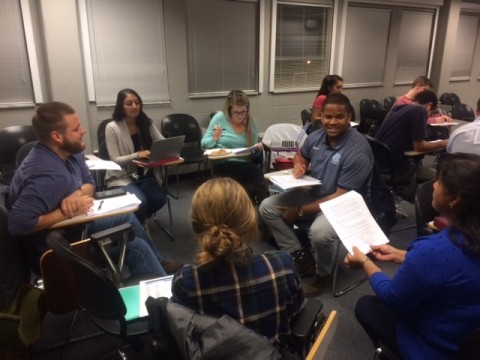Interprofessional education (IPE) is a hot topic right now, but building collaborations can be challenging. Let’s face it, it’s especially challenging in an academic model where each professional school has its own priorities, funding structures, and schedules. Faculty who have a passion for building IPE are aware of these challenges but will also quickly tell you how rewarding addressing these challenges can be! Simply put, designing IPE will be one of the most exhausting, rewarding, and all-consuming innovations you can do as an educator. In this blog, I will share one strategy of involving students in the development of an IPE population health course.
One chilly February day, I was called to my Dean’s office at the University of North Carolina at Chapel Hill School of Nursing to meet with the Director of a large primary care practice in NC. The Director was interested in sending his nurses to our Clinical Nurse Leader (CNL) program as they were exhibiting signs of burnout due to their new job requirements building a Patient Centered Medical Home (PCMH) and focusing on outcomes-based care. After he was finished describing his frustration, I responded “Well you don’t have a nursing problem, you have a teamwork problem!” He then gave me a look of bewilderment which resulted in my Dean giving me a look that I never want to see again in my faculty career! The meeting abruptly ended and thought I would never be invited to another meeting again.
But he was back about a week later, admitting he’d been a bit flummoxed by my comment, but had realized I was right; he did have a teamwork problem. He needed to train his workforce to respond to the shifting healthcare climate. He also wanted to create a pipeline of graduates trained in population health management. The problem was, there was no such curriculum at UNC. We brainstormed what such a curriculum would look like and within an hour we were both dreaming up an implementation plan.
We spent February through July identifying key faculty in six health professions. In August, we had our first group meeting, where we developed a Logic model for our program and agreed on a content outline for the curriculum. I was also selected as a Macy Faculty Scholar which provided some funding for this project as well as a national mentor for support. My workload buy-out was the only funding we had for this large project, and the goal was to have two courses up and running in ONE YEARS time. During this year, we had a year to develop and implement this project, have the project approved by six curriculum committees, and recruit students. For those of you in academia, you are well aware of how ambitious this sounds!

By November, we had a complete program outline, with the plan for a 3-credit hour didactic course in the fall semester, with an interprofessional primary care clinical immersion experience the following spring. This sounds like a hefty goal—and remember I am the only faculty member with any funding—but I was blessed with a team of interprofessional faculty who believed in the need for this project. As I tossed and turned at 3 AM wondering how to make all of this happen in such a short time with such limited resources, an idea came to me: Could we utilize our current students in a strategic way to help us design this program? ABSOLUTELY! This innovative approach not only allowed us to create the course and meet our deadline, it helped us design a truly interprofessional course that was designed “by students, for students.” You can read about this ‘outside the box’ strategy in the December issue of Nurse Educator.
So now it’s your turn—do you see the benefit in utilizing students in this way in your course design?
Meg Zomorodi PhD, RN, ANEF, FAAN

Meg Zomorodi PhD, RN, CNL is a Clinical Associate Professor at the University of North Carolina at Chapel Hill School of Nursing and a Macy Faculty Scholar. Meg serves as the Coordinator for Health Care Systems and is passionate about interprofessional education. She recently has partnered with Well Care Home Health to create opportunities for Health Care Systems graduate students in home health care. You can find her on Twitter at @MegZ4UNC.

